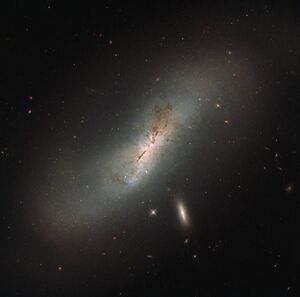Astronomy:NGC 4424
Coordinates: ![]() 12h 27m 11.583s, +09° 25′ 13.87″
12h 27m 11.583s, +09° 25′ 13.87″
| NGC 4424 | |
|---|---|
 NGC 4424 as taken by Hubble Space Telescope; the smaller galaxy LEDA 213994 is below center | |
| Observation data (J2000 epoch) | |
| Constellation | Virgo |
| Right ascension | 12h 27m 11.575s[1] |
| Declination | +09° 25′ 14.32″[1] |
| Redshift | 0.00146[2] |
| Helio radial velocity | 442[3] |
| Distance | 13.5 Mly (4.1 Mpc)[4] |
| Group or cluster | Virgo Cluster[5] |
| Characteristics | |
| Type | SB(s)a peculiar[2] |
| Mass | 3.8+2.3 −1.4×108[4] M☉ |
| Other designations | |
| IRAS 12246+0941, UGC 7561, MCG+02-32-058, PGC 40809[6][7] | |
NGC 4424 is a spiral galaxy located in the equatorial constellation of Virgo. It was discovered February 27, 1865 by German astronomer Heinrich Louis d'Arrest.[8] This galaxy is located at a distance of 13.5[4] million light years and is receding with a heliocentric radial velocity of 442 km/s.[3] It has a morphological class of SB(s)a,[2] which normally indicates a spiral galaxy with a barred structure (SB), no inner ring feature (s), and tightly-wound spiral arms (a). The galactic plane is inclined at an angle of 62° to the line of sight from the Earth. It is a likely member of the Virgo Cluster of galaxies.[5]
The galaxy NGC 4424 has a peculiar morphology with shells that give the appearance of a galaxy merger within the last half billion years. It has a long tail of hydrogen stretching 110 kpc to the south that is likely due to stripping from ram pressure. Because of the lack of gas, star formation has completely ceased in the outer parts of the galaxy, while there is still a mild amount occurring in the inner region. NGC 4424 will most likely end up as a lenticular galaxy by three billion years from now.[5]
There is no indication of a compact source of X-ray emission in the nucleus, but there is an ionized tail stretching ~10 kpc from the core.[5] The velocity dispersion at the core suggests there is a supermassive black hole (SMBH) with a mass of (0.8±0.2)×105 M☉.[9] Hubble images of this galaxy show a tidally-stretched cluster located at a projected distance of ~400 pc from the nucleus. This is probably the core of a captured galaxy. It contains a compact source that is emitting X-rays and may be an active massive black hole. In time this may merge with the core SMBH of NGC 4424.[9]
Two supernovae have been observed in NGC 4424. Max Wolf discovered SN 1895A (type unknown, mag. 12.5) on March 16, 1895.[10] Type Ia supernova designated SN 2012cg was discovered in this galaxy by the LOSS program from images taken May 17, 2012.[11] It reached maximum light nine days later at the end of May.[12] The supernova reached a peak absolute magnitude of −19.50±0.31 in the B (blue) band and synthesized 0.72±0.31 M☉ of the radioactive isotope nickel-56.[2] The available observations favor a merger of double degenerate progenitors as the source for the event.[13] The proximity of the galaxy made this one of the best studied supernova explosions to date.[13]
References
- ↑ 1.0 1.1 Brown, A. G. A. (August 2018). "Gaia Data Release 2: Summary of the contents and survey properties". Astronomy & Astrophysics 616: A1. doi:10.1051/0004-6361/201833051. Bibcode: 2018A&A...616A...1G. Gaia DR2 record for this source at VizieR.
- ↑ 2.0 2.1 2.2 2.3 Chakradhari, N. K. et al. (August 2019). "Optical and UV studies of type Ia supernovae SN 2009ig and SN 2012cg". Monthly Notices of the Royal Astronomical Society 487 (2): 1886–1904. doi:10.1093/mnras/stz1358. Bibcode: 2019MNRAS.487.1886C.
- ↑ 3.0 3.1 Tully, R. Brent (May 2015). "Galaxy Groups: A 2MASS Catalog". The Astronomical Journal 149 (5): 14. doi:10.1088/0004-6256/149/5/171. 171. Bibcode: 2015AJ....149..171T.
- ↑ 4.0 4.1 4.2 Lianou, S. et al. (November 2019). "Dust properties and star formation of approximately a thousand local galaxies". Astronomy & Astrophysics 631: 19. doi:10.1051/0004-6361/201834553. A38. Bibcode: 2019A&A...631A..38L.
- ↑ 5.0 5.1 5.2 5.3 Boselli, A. et al. (December 2018). "A Virgo Environmental Survey Tracing Ionised Gas Emission (VESTIGE). IV. A tail of ionised gas in the merger remnant NGC4424". Astronomy & Astrophysics 620: 16. doi:10.1051/0004-6361/201833914. A164. Bibcode: 2018A&A...620A.164B.
- ↑ "HyperLeda -object description". http://leda.univ-lyon1.fr/ledacat.cgi?o=NGC4424.
- ↑ "NGC 4424". SIMBAD. Centre de données astronomiques de Strasbourg. http://simbad.u-strasbg.fr/simbad/sim-basic?Ident=NGC+4424.
- ↑ Anderson, Natali (Mar 27, 2017). "Hubble Observes Barred Spiral Galaxy NGC 4424". Science News. http://www.sci-news.com/astronomy/hubble-barred-spiral-galaxy-ngc-4424-04732.html.
- ↑ 9.0 9.1 Graham, Alister W. et al. (December 2021). "Potential Black Hole Seeding of the Spiral Galaxy NGC 4424 via an Infalling Star Cluster". The Astrophysical Journal 923 (2): 14. doi:10.3847/1538-4357/ac235b. 146. Bibcode: 2021ApJ...923..146G.
- ↑ Transient Name Server entry for SN 1895A. Retrieved 28 March 2023.
- ↑ Kandrashoff, M. et al. (May 2012). Green, D. W. E.. ed. "Supernova 2012cg in NGC 4424 = Psn J12271283+0925132". Central Bureau Electronic Telegrams 3111 (1). Bibcode: 2012CBET.3111....1K.
- ↑ Munari, U. et al. (April 2013). "BVRI lightcurves of supernovae SN 2011fe in M101, SN 2012aw in M95, and SN 2012cg in NGC 4424". New Astronomy 20: 30–37. doi:10.1016/j.newast.2012.09.003. Bibcode: 2013NewA...20...30M.
- ↑ 13.0 13.1 Shappee, B. J. et al. (March 2018). "Strong Evidence against a Non-degenerate Companion in SN 2012cg". The Astrophysical Journal 855 (1): 10. doi:10.3847/1538-4357/aaa1e9. 6. Bibcode: 2018ApJ...855....6S.
External links
 |

